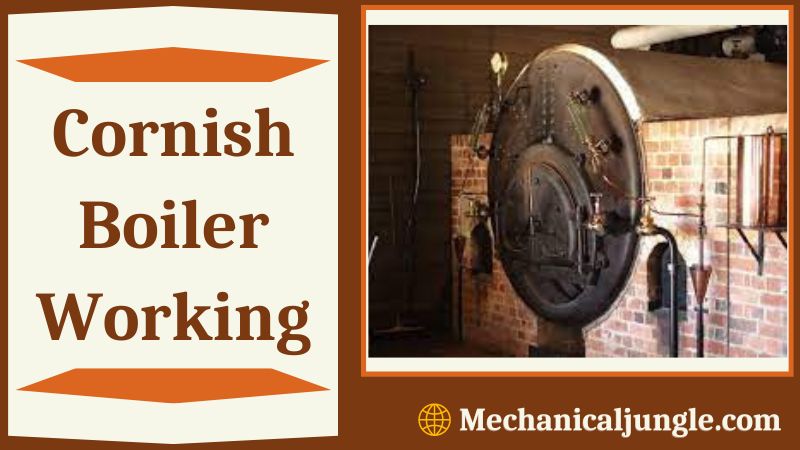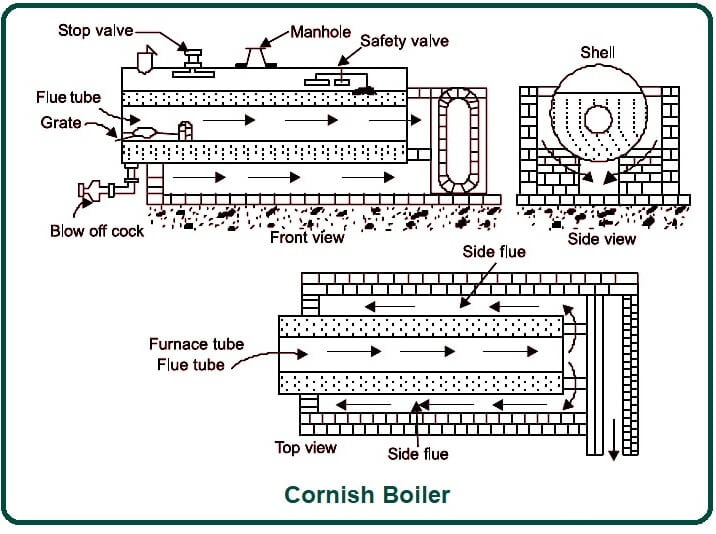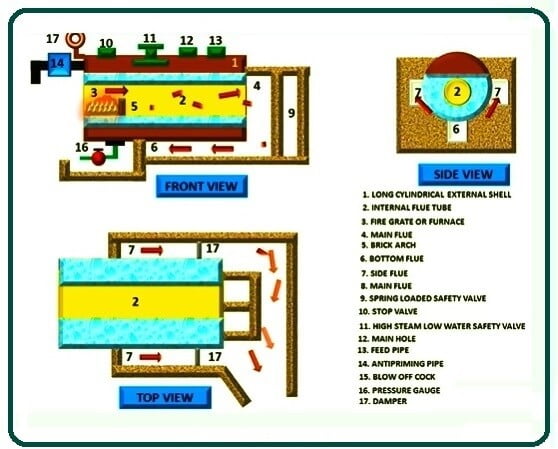
What Is Cornish Boiler?
 The Cornish boiler is a horizontal fire tube boiler with an internal fire tube. Cornish boilers were first manufactured in the year 1812 by Richard Trevithick. Cornish boilers have a long horizontal cylindrical shell. This boiler has only one fire watch running from front to back.
The Cornish boiler is a horizontal fire tube boiler with an internal fire tube. Cornish boilers were first manufactured in the year 1812 by Richard Trevithick. Cornish boilers have a long horizontal cylindrical shell. This boiler has only one fire watch running from front to back.
This fire watch is not centered inside the shell. This is offset from the fire watch center. This firetube is offset from the center because the shell is never fully filled with water, some space of the upper part of the shell is left for steam, and the firetubes are placed in such a way that it almost in the middle of the water-filled area.
In Cornish boilers, the shell has a length of 4 to 7 meters, and the shell has a diameter of 1.25 to 1.75 meters.
Parts of Cornish Boiler:
#1. Shell
A shell contains water as well as a tube. The transfers of heat between water take place in the shell. And the shell is also such that it covers all the components of the boiler and is also called the main body.
#2. Grate and Furnace
This is the place in the fire watch where coal will be kept and burned. The furnace is the part where coal or fuel enters and burns inside it. Grat is the part where heat is developed with the help of fuel burning in it.
#3. Furnace
A furnace acts like an intermediary that you know why? Because it is connected between the fire hose and the combustion chamber. Here the fuel burns and produces heat.
#4. Combustion Chamber
Here the fuels burn in the combustion chamber and produce heat which is then supplied to the tube; here, water is condensed. The combustion chambers are connected to the furnace.
#5. Ash pit
Fuel ash here is completely burnt and has no use inside the boiler.
#6. Chimney
The chimney is here to release exhaust gases into the atmosphere.
#7. Smokebox
A smokebox is provided here to collect smoke and further sends it to the chimney.
#8. Water level Indicator
It is a device that details the water level of a boiler. This works even when the water is over the limit, or the water is below the limit.
#9. Safety Valve
The safety valve is another type of instrument, which is used for the purpose of safety, and it works even when no other indicator works.
#10. Man Hole
This is the main hole from which an engineer will enter and replace it when any component inside the boiler is damaged.
#11. Stop Valve
Stop valves are also used to regulate the control of things.
#12. Blow off valve
A flick of the valve is used to clean the boiler by discharging water and sediment from the bottom of the boiler.
Working Principle of Cornish Boiler:

The burning of coal produces heat which is then sent to the tube, and water is circulated here. Why is the water surrounded on its own? Because we supply water here & with the use of an instrument, the water level indicator, we measure the water level.
So now there is so much heat in the tube that the water starts heating up, which means that the water first converts to saturated steam, and then it is further heated and converted to superheat steam which is now working. Steam can be used for various purposes.
Meanwhile, the burning coal ash here falls into the ash pit, and from here, it becomes smoky, and the gas will leave the chimney in the environment. And we take out the ashes from the system and clean it.
Construction of Cornish Boiler:
The shortest part of the boiler is a long cylindrical outer shell. It is the outermost part of Cornish boilers, which contains other boiler parts. Inside the shell is an internal fire hose near the bottom of the boiler.
The fire watch is positioned in such a way that it is in the center of the Cornish boiler’s water area. The furnace and furnace are present on the front side of the boiler.
The coal is prepared for grinding through a fire hole. A brick arc is also given to prevent the burning coal ash from entering the fire tube and the flue tube.
Two flue tubes are present on two sides of the boiler and are called side flues, and one is presented at the bottom of the boiler and is known as a bottom flue. There is another grip tube called the main grip tube.
Through these main flue tubes, the flue gases reach the chimney. This chimney is used to pass flue gases and smoke into the atmosphere from the main flu tube. Apart from these parts, some mountings are installed on this boiler.
A safety valve that is spring-loaded is placed on the boiler to release excess steams pressure whenever there is high steams pressure inside the boiler.
There is another mounting stop valve and is used to regulate the steam generated between the steam pipes, and the boiler is located on the top of the boiler.
A High Steam Low Water Safety Valve A stop is also provided near the valve & is used to release the generated steam when the water level falls below a certain level. There is a water feed pipe inside the boiler to fill the water.
This feed pipe is controlled by the feed valve. The steam produced inside the boiler contains a large amount of water in the steam locations and is called priming.
An anti-precision pipe is provided to separate the water as far as possible. Blow-off coke is used to remove the sludge inside the boiler floor.
This blow-off cock can be used the inspire to completely drain water from the boiler. The main hole also exists, which is used to inspect inside the boiler.
There is also a pressure gauge inside the boilers, which is used to know the amount of pressure inside the boiler when it is under operation. Boilers are located on two sides of the boiler used to regulate the flow of air, and it also controls steam generation.
Application of Cornish Boiler:
Here, the different applications of the cornish boiler are as follows.
- Cornish boilers are used in many industries, such as sugar, paper, tires, chemicals, etc.
- Cornish boiler is also used to produce steam to run steam turbines.
- It is also found in many marine industries.
Advantages of Cornish Boiler:
Here, the different advantages of the cornish boiler are as follows.
- Cornish boilers have a very simple design and easy construction.
- It is a compact and portable boiler.
- This can overcome load fluctuations during boiler operation.
- The manufacturing and maintenance costs of this boiler are very low.
Disadvantages of Cornish Boiler:
Here, the different disadvantages of the cornish boiler are as follows.
- The low steam generation rate of about 1350 kg/hr.
- It can take a maximum steam pressure of 10.5 bar.
- The horizontal structure requires more land.
Frequently Asked Questions (FAQ) about Cornish Boilers:
What is a Cornish Boiler and how does it work?
A Cornish Boiler is a type of fire tube boiler characterized by its horizontal cylindrical shell and internal fire tube. It works by burning fuel (typically coal) in a furnace, generating heat that heats water in the boiler’s tubes to produce steam.
Who invented the Cornish Boiler and when?
The Cornish Boiler was invented by Richard Trevithick in the year 1812.
What are the main components of a Cornish Boiler?
The main components include the shell (cylindrical outer body), fire tube (internal tube where combustion occurs), furnace (where fuel is burned), chimney (exhausts gases), and various mountings like safety valves and water level indicators.
Where are Cornish Boilers typically used?
Cornish Boilers find applications in industries such as sugar, paper, textiles, and marine settings where steam power is needed for operations.
What are the advantages of using a Cornish Boiler?
Advantages include its simple design, low manufacturing and maintenance costs, compact size, and ability to handle load fluctuations effectively.
What are the disadvantages of Cornish Boilers?
Disadvantages include a relatively low steam generation rate, limited maximum steam pressure capability, and requiring more land due to its horizontal structure.
How is safety ensured in Cornish Boilers?
Safety is ensured through mechanisms like safety valves that release excess steam pressure and water level indicators that monitor the water level to prevent dry firing.
What maintenance is required for Cornish Boilers?
Regular inspection of tubes, cleaning of ash pits and flues, and monitoring of safety devices are essential for maintaining Cornish Boilers.
How efficient are Cornish Boilers compared to other types?
Cornish Boilers are known for their simplicity and reliability but may have lower efficiency compared to more modern boiler designs that utilize advanced combustion and heat transfer technologies.
What is the typical lifespan of a Cornish Boiler?
With proper maintenance and care, a Cornish Boiler can have a long lifespan, often exceeding several decades, depending on operating conditions and usage.

